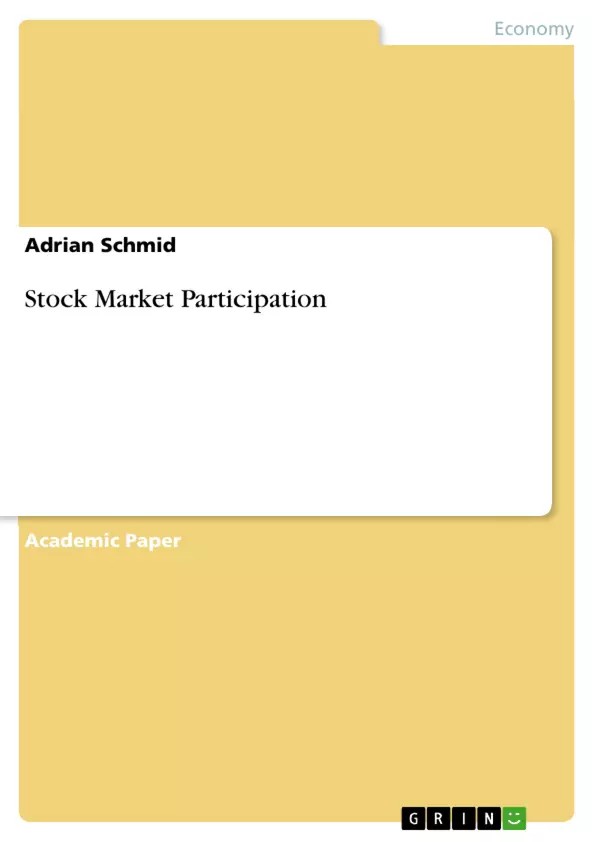The field of household finance is confronted with the phenomena called “stock market participation puzzle” (Haliassos, 2003) which describes that most households do not hold stocks, despite that there are higher expected returns on stocks than on risk free assets (Haliassos, 2003). According to Haliassos and Bertaut (1995), 75% of households in the United States do not own stocks directly although returns on equity exceed the returns on risk free assets. This issue does not only concern households themselves, financial intermediaries, and stock issuers. It is also relevant for questions concerning privatisation, asset pricing, and tax rates on capital gains (Haliassos and Bertaut, 1995). The participation rate can directly affect the equity premium as argued by Mankiw and Zeldes (1991), and Heaton and Lucas (1999).
Stock market participation in this seminar thesis refers to households participating in the market by holding stocks, excluding retirement accounts. The purpose is to demonstrate five factors discussed in financial literature that contribute to solve the stock market participation puzzle or reasons why limited stock market participation can be observed: Deviation from standard expected utility (Haliassos, 2003; Epstein and Zin, 1990; Haliassos and Hassapis, 1999; Diecidue and Wakker, 2001; Haliassos and Bertaut, 1995), more restricted borrowing constraints (Constantinides, Donaldson, and Mehra, 2002; Cocco, Gomes, and Maenhout, 2005; Haliassos, 2003), participation and entry costs (Guiso and Japelli, 2004; Gollier, 2002; Haliassos and Michaelides, 2003; Paiella, 2001; Vissing-Jorgensen, 2002; Haliassos, 2003), lack of financial awareness (Guiso and Jappelli, 2004), and financial illiteracy (van Rooij, Lusardi, and Alessie, 2007; Arrondel, Debbich, and Savignac, 2012; King and Leape, 1987).
Table of Contents
- 1 Introduction
- 2 What Theory predicts about Households Stockholding Decision
- 3 Contributions to Explain Limited Stock Market Participation
- 3.1 Deviation from Standard Expected Utility
- 3.2 More Restricted Borrowing Constraints
- 3.3 Participation and Entry Costs
- 3.4 Lack of Financial Awareness
- 3.5 Financial Illiteracy
- 4 Achieve More Stock Market Participation
- 4.1 Advertisement
- 4.2 Targeted Financial Education
- 4.3 Cost Reduction
- 5 Conclusion
Objectives and Key Themes
This seminar thesis examines the "stock market participation puzzle," a phenomenon observed in household finance where many households choose not to invest in stocks, despite their potentially higher returns compared to risk-free assets. The thesis aims to demonstrate five factors contributing to this limited participation, providing insights into why households may deviate from standard economic theory's predictions.
- Deviation from Standard Expected Utility
- More Restricted Borrowing Constraints
- Participation and Entry Costs
- Lack of Financial Awareness
- Financial Illiteracy
Chapter Summaries
- Chapter 1 provides an introduction to the "stock market participation puzzle," highlighting the observed discrepancy between theoretical predictions and actual household behavior. It also outlines the broader implications of limited stock market participation.
- Chapter 2 delves into the theoretical framework predicting household stockholding decisions, emphasizing that under standard assumptions, a risk-averse household should always allocate a marginal amount to stocks when returns exceed those of risk-free assets.
- Chapter 3 explores five key factors contributing to limited stock market participation, including deviations from standard expected utility theory, borrowing constraints, participation and entry costs, lack of financial awareness, and financial illiteracy.
- Chapter 4 proposes three possible solutions to encourage greater stock market participation: targeted financial education, cost reduction, and advertising campaigns.
Keywords
The key terms and concepts central to this seminar thesis include household finance, stock market participation puzzle, limited participation, expected utility theory, risk aversion, borrowing constraints, participation costs, financial awareness, financial literacy, targeted financial education, cost reduction, and advertising campaigns.
- Quote paper
- Adrian Schmid (Author), 2014, Stock Market Participation, Munich, GRIN Verlag, https://www.grin.com/document/494290



